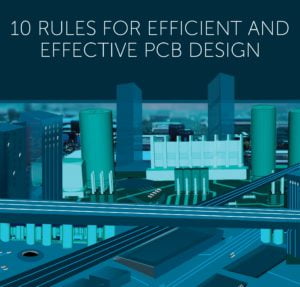8 PCB Design and Layout Tips You Should Know
PCB’s are all around us and we are probably never more than a metre away from a PCB at all times. Your smartwatch/fitness tracker, your laptop or your mobile. We can’t go a day without relying on a PCB somewhere! And as a result, PCB design is more important than ever. In this post, we explore some of the most important elements of successful PCB design and our top 8 layout tips that you should know.
1. Node Location Is Critical
Perhaps the most important tip on our list is this – Node accessibility. This could help solve your design issues and solve issues when testing. If nodes aren’t accessible, testing will be even harder whatever type of nodes you have used. If they are easy to probe then they are easy to test.
2. Space Matters
Today’s circuit boards support far more components per square centimetre than ever before. That’s great from an end-user standpoint. The more components on a board, the more functionality it supports, and the more users can do with the device. However, what is an advantage for end users can be a challenge for designers.
Simply put, the more components you add to a board, the more cramped they become within the design. And, make no mistake, component spacing matters a lot. Why is that? You’ll find several reasons. One of those is that without the appropriate amount of spacing, you lack room for wire routing. Another challenge is that those components create heat, and the closer they’re packed, the more heat builds up in the board. In some cases, that might be enough to compromise the board material itself, particularly if you’re using something like FR-4 rather than a material designed to handle high levels of heat.
3. Feeling the heat
Heat will always be a problem, but it is not insurmountable. One quick tip to help you get around high-heat-related issues is to add extra copper around surface mount components. This creates additional surface area and helps dissipate more heat, faster, effectively turning a portion of the PCB design into a heatsink.
4. Pay Attention to Arrangement
Sometimes, rotating your components is simply not enough. When that happens, it’s important to come at the situation with a bit of strategy in terms of component arrangement. How, though?
Cascaded Components: Cascaded components play a vital role in many PCB design options. However, they can be challenging to arrange correctly. Keep them near one another, and make sure that they are in sequence on the board. That will immediately remove the challenge of trying to route traces all across the board to connect cascaded components located in different areas.
Consolidate: Why use multiple smaller resistors when a single higher resistance one will work better? Consolidating your design ensures that there’s more room for components and traces, as resistors will take up less of your available space.
Cascade from the Edge: When laying out your PCB design, identify any component that must be attached via a connector placed on or near the edge. Locate those components as close to the connector as you can. The rest of the chain should cascade away from that point, grouped into functional blocks near one another and in sequence.
5. Making space
Does the following situation sound familiar? You’re staring at your PCB design, struggling to fit each component in and route traces between them. No matter where you put them, you’re left with problems, particularly if the board is smaller.
The answer? Rotate your components and find the best arrangement that allows you to route traces directly between them while maximizing the use of space across the entire board. This can take some time and effort, but it’s well worth the minimal investment you’ll make.
6. That Shrinking Feeling
Struggling with an unrouteable board? Use smaller components. By going with a smaller footprint, you leave more room for copper traces to pass each component. Proper spacing is easier to maintain with smaller components, too, helping you avoid overcrowding the board and the other problems that go hand in hand with stacking components too close to one another.
What should you do? While quad flat package components might be your first option, you might want to consider going with ball grid array components, instead. Of course, there is a trade-off here – smaller components make repair work more challenging.
7. Dense Boards
If you are struggling with PCB design, chances are good that the space required for traces, vias, and clearance is a problem. You can get around that by going denser. With HDI, you can create very dense boards with very dense traces, clearances, and vias that still deliver performance. However, you do need to consider controlled impedance routing, differential pairs, and check creepage, clearance, and width when it comes to high-current and high-voltage design.
8. Keep the Noise Down
Signal noise can be problematic when it comes to some traces. However, placing high-frequency signal carrying traces too close together can couple those signals, ratcheting up the noise and possibly creating problems with traces where no noise is desired. Make sure that you keep noisy digital traces away from analog traces to avoid this problem.
More about Quadra Solutions PCB Design Service
We have been designing, assembling and fabricating PCB’s for over 20 years and our ability to design and manufacture the highest quality PCB designs and prototypes means the world to every single member of the Quadra team.You can rely on our highly experienced and IPC CID+ accredited team of PCB Design Engineers to provide a full range of PCB Design Services that leave you free to focus on the design concept and product strategy.
Our ISO 9001 accredited team deliver complex, high-speed multi-layered circuit board design layout, testing, library management and manufacturing services for hundreds of happy customers each year, using a wide range of PCB design software packages including;
- Altium
- Mentor
- eCADSTAR and CADSTAR
- PADS
- Cadence

Quadra PCB design and Manufacturing Services
- Data Preparation
- Library Creation
- Circuit Board Design
- Layout Service
- PCB Assembly and Manufacture
- PCB Reverse Engineering
- Reverse engineering
- High-Speed PCB Design
- Post PCB Layout
- ECAD / MCAD Integration




